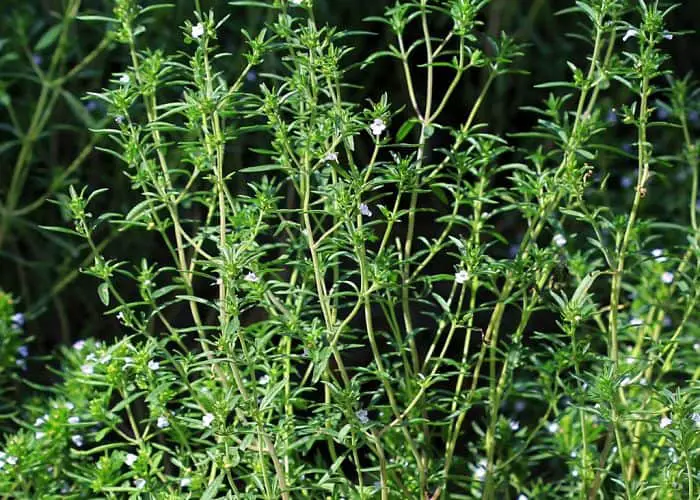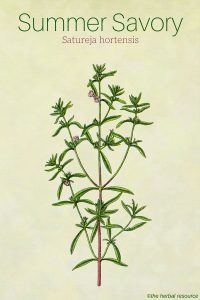Botanical Name: Satureja hortensis.
Other Common Names: Garden savory, ajedrea de jardin (Spanish), hsiang po ho (Chinese), Bohnenkraut (German), sarriette des jardins (French), sommersar (Norwegian), sommarkynde (Swedish), sar (Danish), Kesäkynteli (Finnish).
Habitat: Summer savory is probably native to the eastern Mediterranean and countries around the Black Sea. It is widely cultivated as a spice and to some extent, its medicinal properties.
Today, it is cultivated in Spain, France, former Yugoslavia and North America.
The plant grows best in sandy, loamy and well-drained soil. It does not grow in shade and should be planted in full sun. It tolerates both dry or moist soil and can survive drought.
Description: Sommer savory is an annual plant that belongs to the mint or deadnettle family (Lamiaceae). It can grow 20-30 cm high with woody and richly branched stems. The leaves are narrow, lanceolate, green or almost black green with small scent glands.
The small white or violet flowers are hermaphrodite (have both male and female organs) and are pollinated by insects. The plant is usually in bloom from June to September and the seeds ripen from August to September. Summer savory is self-fertile.
Plant Parts Used: All of the above-ground parts of the plant are used in herbal medicines.
The herb can be used both fresh or dried for later use.
Summer savory can be harvested throughout the summer but the herb’s taste is considered best before the flowering begins. The leaves are often deep-frozen to ensure fresh supply all year around.
It is possible to extract an essential oil from summer savory.
Uses and Health Benefits of Summer Savory
‘
Active Ingredients and Substances: The plant contains tannins, mucins, phenols, resins and essential oils.
The main constituents of the oil are carvacrol, beta-pinene, beta-phellandrene, limonene, and borneol.
Medicinal Properties
When using summer savory as a medicinal herb, the entire herb is used (especially the flowering tops). The herb is very aromatic and has appetizing-enhancing, expectorant, digestive-regulating and sudorific effect.
Taken internally, the herb is viewed as a good remedy for nausea, diarrhea, flatulence, bloating and other digestive disorders.
It is also used to treat a sore throat, colic, asthma and irregular menstruation. Herbal tea made from the herb can be used as an antiseptic gargle.
Because of its astringent and anti-inflammatory effect, a liniment of the herb can be used externally to ease the pains of inflamed joints.
In the same manner as parsley (Petroselinum crispum), summer savory is used as a treatment for insect stings and bites. The fresh plant material is pressed against the affected area and helps to ease the burning sensation and reduce the swelling.
An extract of summer savory is also regarded as an invigorating tonic and was presumably highly sought after by the ancient Egyptians as an aphrodisiac.
In the past, the herb was known as the “love herb” and it was often associated with supernatural beings who radiated a special erotic force. In many monasteries, during the Middle Ages, monks were forbidden to cultivate it so it would not compromise their chastity vows.
Essential oil
The essential oil present in summer savory is extracted by steam distillation. The oil is colorless or slightly yellow and has a fresh spicy scent.
The oil is regarded to have many of the same medicinal properties as the fresh or dried herb, and it is thought to have antispasmodic, anti-infectious, aphrodisiac, astringent, and expectorant properties.
In addition, it has both antibacterial and antifungal effect and can be used to expel parasitic worms (anthelmintic).
The oil is not used in aromatherapy but is occasionally used in perfumery because of its fresh, herbaceous odor.
Summer Savory Uses as a Spice
Despite its medicinal uses, summer savory is mostly used as a culinary herb and it has been used as a food additive for over 2000 years.
It is considered milder than its close relative winter savory (Satureja montana).
In cooking, the fresh or dried leaves are used. Properly dried summer savory should be dark green with a strong spicy odor with a mild peppery flavor. The flavor can also be reminiscent of sage (Salvia officinalis) and marjoram (Origanum majorana).
Taste wise in cooking, the herb can essentially replace both salt and pepper, which can be of great use to those who are on a salt-free diet. It is a relatively powerful herb and takes some time to get used to so it should be used with some caution.
As a spice, the herb is used especially for fatty meat, in bean or pea soup, with red and white cabbage (often with thyme), in different types of salads, in tomato sauce and tomato soup, as well many soup recipes.
The herb is often used as an addition in various spice mixtures intended for soups, meat and vegetable dishes. Furthermore, it is well known as an important spice in sausage making.
Dosage and Administration
As an herbal tea: Add 2 or 3 teaspoons of the dried herb in a cup of boiling water. Common therapeutic dosage is one cup daily.
Possible Side Effects and Interactions of Summer Savory
The summer savory’s essential oil should not be used during pregnancy. The oil can cause irritation to the skin and mucous membranes. The herb should not be used therapeutically as a long-term remedy.
Supporting References
Bown, Deni: The Royal Horticultural Society New Encyclopedia of Herbs & Their Uses. London, Dorling Kindersley 2002.
Lawless, Julia: The Illustrated Encyclopedia of Essential Oils. Shaftesbury, Element Books 1995.
Lee, William H. & Lynn Lee: Herbal Love Potions. New Canaan, Keats Publishing Inc. 1991.
Thordur Sturluson
Latest posts by Thordur Sturluson (see all)
- What is the Difference Between Hemp and Marijuana? - June 3, 2019


Leave a Reply